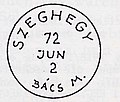Lovćenac
Lovćenac
Ловћенац | |
|---|---|
Village | |
 The train station in Lovćenac in 2003 | |
| Country | |
| Province | |
| Population (2002) | |
| • Total | 3,693 |
| Time zone | UTC+1 (CET) |
| • Summer (DST) | UTC+2 (CEST) |

Lovćenac (Serbian Cyrillic: Ловћенац) is a village located in the Mali Iđoš municipality, in the North Bačka District of Vojvodina, Serbia. The village has a Montenegrin ethnic majority and a total population of 3,693 people (2002 census).
Name
In Serbian and Montenegrin, the village is known as Lovćenac (Ловћенац), in German as Sekitsch (in the past rarely Winkelsberg), and in Hungarian as Szeghegy.
Its former name in Serbian was Sekić (Секић). After the World War II, the village was named Lovćenac by the Montenegrin settlers after Mount Lovćen in Montenegro.
The original Hungarian name of the village was Szeghegy, but Hungarians also used Serbian version of the name in the forms Szikics and Szekics, as well as Germans in the form Sekitsch. One very rare alternative German name was Winkelsberg.
History
The village first appeared in history in 1476. During the Ottoman administration, the village of Sekić was populated by ethnic Serbs.[1] The ethnic Germans settled there in 1786. These German settlers, originally from all over, came to be a distinct group known as Vojvodina Germans (Wojwodinedeutsche), a branch of the Danube Swabians since 1918. At its peak (in 1910), the village had a population of 5,394 people,[2] mostly Germans.[3] Following the Axis occupation of this part of Yugoslavia (1941-1944) and end of World War II, most of the Germans left the country, together with the defeated German army. Those who remained were interned into prison camps. After camps were disbanded in 1948, most of the remaining Yugoslav Germans emigrated to Germany because of economic reasons in the next decades. After World War II, the village was populated with settlers from Montenegro, who now form a majority of the population.
Ethnic groups
1971
According to the 1971 census, ethnic Montenegrins comprised 70.91% of population of the village.
2002
According to the 2002 census, the population of the village numbered 3,693 people, including:
- 2,100 (56.86%) Montenegrins
- 1,242 (33.63%) Serbs
- 107 (2.90%) Hungarians
- others.
Historical population
- 1961: 4,800
- 1971: 4,159
- 1981: 4,016
- 1991: 4,049
Culture
The society of Montenegrins in Serbia known as Krstaš is based in Lovćenac.
Notable people
- Sofija Pekić, former female Serbian basketball player, Olympic bronze medalist
- Danilo Popivoda, former Slovenian football player of Serbian descents
Twin towns – Sister cities
Lovćenac is twinned with:
 Cetinje, Montenegro, since 2012
Cetinje, Montenegro, since 2012
Notes
- ^ Dr Dušan J. Popović, Srbi u Vojvodini, knjiga 1, Novi Sad, 1990, page 113.
- ^ Slobodan Ćurčić, Broj stanovnika Vojvodine, Novi Sad, 1996, page 122.
- ^ http://img190.imageshack.us/img190/3899/vojvodina1910.png
See also
References
- Slobodan Ćurčić, Broj stanovnika Vojvodine, Novi Sad, 1996.
Gallery
-
An intersection on the main road in Lovćenac today.
-
Sekić got its first post office in 1872.
External links
- Krstaš
- Mi smo Crnogorci, sa azbukom od 33 slova, Glas javnosti, 5 February 2006 (about Montenegrins of the village)
45°41′N 19°41′E / 45.683°N 19.683°E




